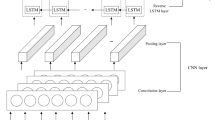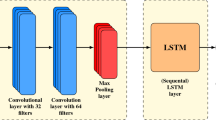Abstract
Load forecasting is essential in power systems for reliable and efficient energy planning and operation. Commercial buildings usually account for 20% of all energy used, with approximately 30% being wasted. Accurate load forecasting for commercial buildings can help improve operational efficiency. For accurate forecasting load, deep learning models have been used. Furthermore, the selection of input data has become important because the forecasting results can vary depending on which input data is trained. However, although various hybrid models have used historical sequential data as input data using the sliding window approach, they did not consider the hourly correlation between factors and load while selecting input data. In this paper, a hybrid convolutional neural network—long short-term memory network is used in combination with a similar day selection model to overcome these limitations by selecting the data of similar days as input data and by considering the hourly correlation with factors. The proposed method is found to be effective by comparing the performance of the traditional methods using convolutional neural or long short-term memory network.




Similar content being viewed by others
References
Kim D, Lee D, Nam H, Joo S (2022) Short-term load forecasting for commercial building using convolutional neural network (CNN) and long short-term memory (LSTM) model. ICEE2022 Conference, Seoul, Korea
Costa A, Keane M, Torrens J, Corry E (2013) Building operation and energy performance: Monitoring, analysis and optimisation toolkit. Appl Energy 101:310–316
Yalcinoz T, Eminoglu U (2005) Short term and medium term power distribution load forecasting by neural networks. Energy Convers Manage 46(9–10):1393–1405
Chitalia G, Pipattanasomporn M, Garg V, Rahman S (2020) Robust short-term electrical load forecasting framework for commercial buildings using deep recurrent neural networks. Appl Energy 278:1
Liu R, Chen T, Sun G, Muyeen SM, Lin S, Mi Y (2022) Short-term probabilistic building load forecasting based on feature integrated artificial intelligent approach. Electr Power Syst Res 206:1
Zheng H, Yuan J, Chen L (2017) Short-term load forecasting using EMD-LSTM neural networks with a Xgboost algorithm for feature importance evaluation. Energies 10(8):1
Mohamed M (2002) Support vector machines for short-term electrical load forecasting. Int J Energy Res 26(4):335–345
Lahouar A, Ben Hadj Slama J (2005) Day-ahead load forecast using random forest and expert input selection. Energy Convers Manag 103:1040–1051
Alam SMM, Ali MH (2020) A new fuzzy logic based method for residential loads forecasting. In: 2020 IEEE/PES transmission and distribution conference and exposition (T&D). IEEE
Dagdougui H et al (2019) Neural network model for short-term and very-short-term load forecasting in district buildings. Energy Build 203:1
Hossen T, Plathottam SJ, Angamuthu RK, Ranganathan P, Salehfar H (2017) Short-term load forecasting using deep neural networks (DNN). In: 2017 North American power symposium (NAPS), pp 1–6
Shabbir N, Amadiahangar R, Raja HA, Kütt L, Rosin A (2020) Residential load forecasting using recurrent neural networks. In: 2020 IEEE 14th International Conference on Compatibility, Power Electronics and Power Engineering (CPE-POWERENG), pp 478–481
Cui C, He M, Di F, Lu Y, Dai Y, Lv F (2020) Research on power load forecasting method based on LSTM model. In: 2020 IEEE 5th Information Technology and Mechatronics Engineering Conference (ITOEC), pp 1657–1660
Bakirtzis AG, Petridis V, Kiartzis SJ, Alexiadis MC, Maissis AH (1996) A neural network short term load forecasting model for the Greekpower system. IEEE Trans Power System 11(2):858–863
Chen Y et al (2010) Short-term load forecasting: similar day-based wavelet neural networks. IEEE Trans Power Syst 25(1):322–330
Park R, Song K, Kwon B (2020) Short-term load forecasting algorithm using a similar day selection method based on reinforcement learning. Energies 13(10):1
Son E, Ahn Y, Lee S, Jo S, Kim D (2018) 24-Hour load forecasting for the campus based on similar days in temperatures. In: Proceedings of the KIEE conference, pp 236–237
Woo J, Bae W, Park J, Park H (2018) Similar day search for input data selection of the Jeju Island load forecasting. In: Proceedings of the KIEE conference, pp 134–135
Yildiz B, Bilbao JI, Sproul AB (2017) A review and analysis of regression and machine learning models on commercial building electricity load forecasting. Renew Sustain Energy Rev 73:1104–1122
Neto AH, Fiorelli FAS (2008) Comparison between detailed model simulation and artificial neural network for forecasting building energy consumption. Energy Build 40(12):2169–2176
Kim T, Jang M, Jeong H, Joo S (2022) Short-term residential load forecasting using 2-step SARIMAX. J Electr Eng Technol 17(2):751–758
Shenoy S, Gorinevsky D, Boyd S (2015) Non-parametric regression modeling for stochastic optimization of power grid load forecast. In: 2015 American Control Conference (ACC), pp 1010–1015
Ji P, **ong D, Wang P, Chen J (2012) A study on exponential smoothing model for load forecasting. In: 2012 Asia-Pacific Power and Energy Engineering Conference, pp 1–4
Wu K et al (2021) An attention-based CNN-LSTM-BiLSTM model for short-term electric load forecasting in integrated energy system. Int Trans Electr Energy Syst 31:1
Rafi SH, Nahid-Al-Masood SRD, Hossain E (2021) A short-term load forecasting method using integrated CNN and LSTM network. IEEE Access 9:32436–32448
Jiang Q, Cheng Y, Le H, Li C, Liu PX (2022) A stacking learning model based on multiple similar days for short-term load forecasting. Mathematics 10(14):2446
Zhang C, Li J, Zhao Y, Li T, Chen Q, Zhang X (2020) A hybrid deep learning-based method for short-term building energy load prediction combined with an interpretation process. Energy Build 225:1
Bian H, Wang Q, Xu G, Zhao X (2022) Load forecasting of hybrid deep learning model considering accumulated temperature effect. Energy Rep 8:205–215
Lu J, Zhang Q, Yang Z, Tu M (2019) A hybrid model based on convolutional neural network and long short-term memory for short-term load forecasting. In: 2019 IEEE power & energy society general meeting (PESGM), pp 1–5
Son J, Cha J, Kim H, Wi Y-M (2022) Day-ahead short-term load forecasting for holidays based on modification of similar days’ load profiles. IEEE Access 10:17864–17880
Alhussein M, Aurangzeb K, Haider SI (2020) Hybrid CNN-LSTM model for short-term individual household load forecasting. IEEE Access 8:180544–180557
Montaha S, Azam S, Rafid AKMRH, Hasan MZ, Karim A, Islam A (2022) TimeDistributed-CNN-LSTM: a hybrid approach combining CNN and LSTM to classify brain tumor on 3D MRI scans performing ablation study. IEEE Access 10:60039–60059
Jang M, Jeong H, Suh D, Joo S (2021) Empirical analysis of the impact of COVID-19 Social Distancing On Residential Electricity Consumption Based On Demographic Characteristics and load shape. Energies 14(22):1
Parizad A, Hatziadoniu C (2022) Deep learning algorithms and parallel distributed computing techniques for high-resolution load forecasting applying hyperparameter optimization. IEEE Syst J 16(3):3758–3769
Scott AJ, Collopy F (1992) Error measures for generalizing about forecasting methods: empirical comparisons. Int J Forecast 8(1):69–80
Jain A, Srinivas E, Kukkadapu SK (2010) Fuzzy based day ahead prediction of electric load using Mahalanobis distance. In: 2010 International Conference on Power System Technology, pp 1–6
Acknowledgements
This work was supported by the Human Resources Program in Energy Technology of the Korea Institute of Energy Technology Evaluation and Planning(KETEP) and the Ministry of Trade, Industry & Energy(MOTIE) of the Republic of Korea (No. 20204010600220). This work was supported by the Korea Institute of Energy Technology Evaluation and Planning(KETEP) grant funded by the Korea government(MOTIE) (No. 20212020900510).
Author information
Authors and Affiliations
Corresponding author
Additional information
Publisher's Note
Springer Nature remains neutral with regard to jurisdictional claims in published maps and institutional affiliations.
Rights and permissions
Springer Nature or its licensor (e.g. a society or other partner) holds exclusive rights to this article under a publishing agreement with the author(s) or other rightsholder(s); author self-archiving of the accepted manuscript version of this article is solely governed by the terms of such publishing agreement and applicable law.
About this article
Cite this article
Kim, D., Lee, D., Nam, H. et al. Short-Term Load Forecasting for Commercial Building Using Convolutional Neural Network (CNN) and Long Short-Term Memory (LSTM) Network with Similar Day Selection Model. J. Electr. Eng. Technol. 18, 4001–4009 (2023). https://doi.org/10.1007/s42835-023-01660-3
Received:
Revised:
Accepted:
Published:
Issue Date:
DOI: https://doi.org/10.1007/s42835-023-01660-3




